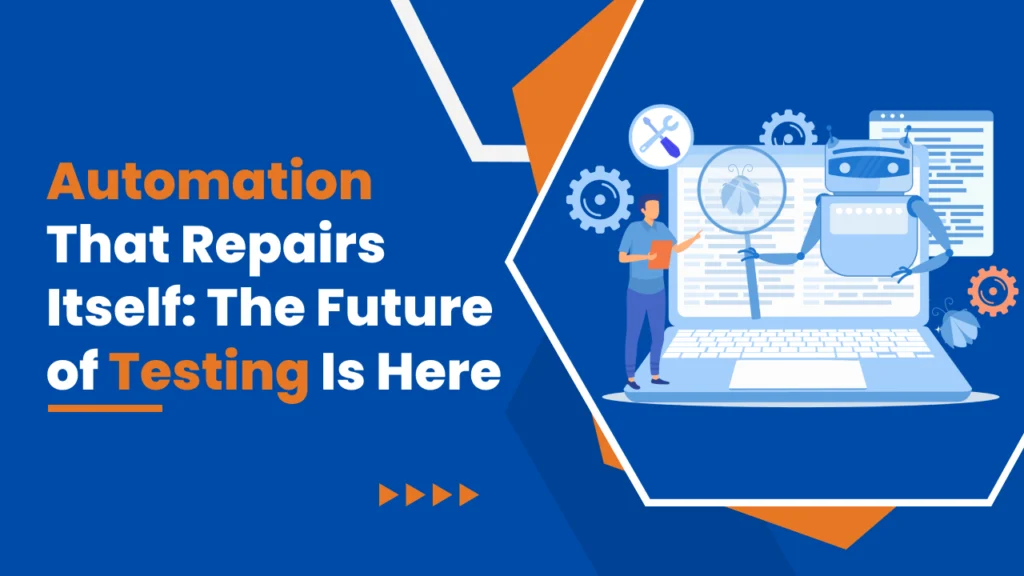
In today’s fast-paced software development landscape, where release cycles are measured in days rather than months, maintaining test automation scripts has become one of the most significant challenges for quality assurance teams. As applications evolve rapidly, even minor changes to user interfaces, workflows, or APIs can break existing test scripts, creating a continuous cycle of maintenance, debugging, and updates. This constant need for script maintenance not only consumes valuable time and resources but also slows down the entire development process, potentially compromising the quality of the final product.
Enter self-healing test automation – a groundbreaking approach that leverages artificial intelligence and machine learning to revolutionize how we maintain and execute test scripts. This innovative technology is rapidly gaining traction as one of the most transformative trends in software testing for 2025 and beyond.
What is Self-Healing Test Automation?
Self-healing test automation refers to AI-powered capabilities in modern testing tools that automatically detect changes in applications under test and adjust test scripts accordingly without requiring manual intervention. Unlike traditional test automation, which breaks when application elements change, self-healing tests can adapt to modifications in the application’s structure, ensuring continuous test execution even as the software evolves.
The concept is analogous to the human body’s natural ability to heal wounds. Just as our bodies can repair damaged tissues without conscious effort, self-healing test scripts can automatically recover from changes in the application that would otherwise cause test failures. This adaptive capability represents a paradigm shift in how we approach test automation maintenance.
How Self-Healing Test Automation Works
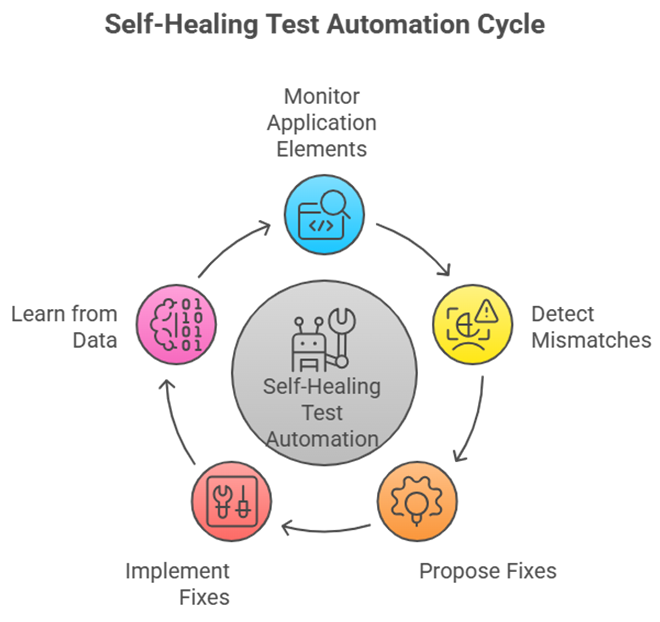
The magic behind self-healing test automation lies in its sophisticated AI and machine learning algorithms. These systems operate through several key mechanisms:
First, the self-healing framework continuously monitors application elements, tracking identifiers such as XPath, CSS selectors, and other locators that test scripts use to interact with the application. When the application changes and an element’s attributes are modified, the system immediately detects the mismatch between what the test script expects and what exists in the updated application.
Instead of simply failing the test, as traditional automation would, the self-healing system springs into action. It analyzes the current state of the application and proposes or implements fixes by identifying alternative ways to locate the changed element. This might involve finding an element with similar properties, recognizing patterns in the application’s structure, or applying heuristics based on previous successful test runs.
What makes this approach particularly powerful is its ability to learn over time. Each test cycle generates valuable data that feeds back into the AI/ML algorithms, training them to better identify “expected behavior” for tests. This continuous learning process enables the system to make increasingly accurate decisions during runtime, distinguishing between genuine application defects and mere structural changes.
A Real-World Example of Self-Healing Test Automation
To better understand how self-healing test automation works in practice, let’s consider a common scenario in e-commerce website testing:
Imagine you’re responsible for maintaining automated tests for an online retail platform. One critical test verifies the checkout process, ensuring customers can successfully complete purchases. The test script identifies the “Add to Cart” button using its HTML ID attribute, which is currently set as id=”add-to-cart-button-123″.
During a routine update, the development team refactors the front-end code, and the button’s ID changes to id=”add-to-cart-btn-v2″. In a traditional test automation setup, this simple change would cause the test to fail, requiring manual intervention to update the script with the new ID.
Here’s how a self-healing test automation system would handle this situation:
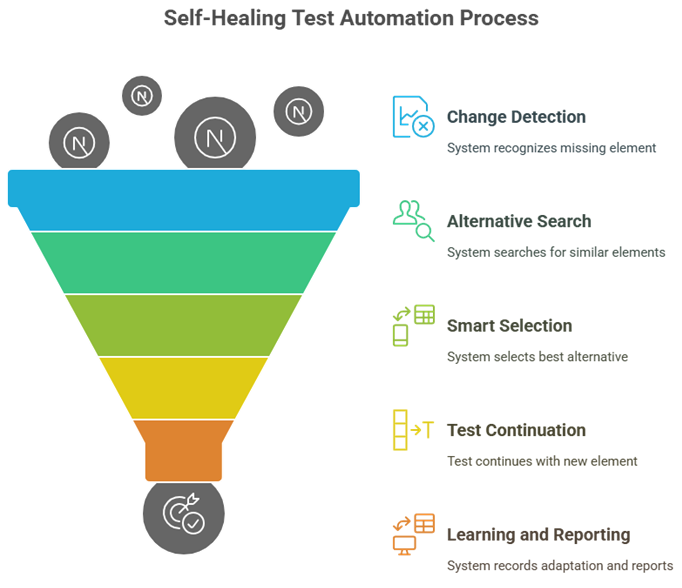
- Initial Test Execution: The test attempts to find the element with ID add-to-cart-button-123 but fails to locate it.
- Change Detection: Instead of immediately failing, the self-healing mechanism recognizes that the expected element is missing.
- Alternative Element Search: The system analyzes the page and identifies potential alternatives based on various properties:
- Elements with similar text content (“Add to Cart”)
- Elements with similar functions (buttons near product displays)
- Elements with partially matching IDs or classes
- Elements in the same position on the page as the original button
- Smart Selection: Based on its analysis and learning from previous test runs, the system determines that the button with ID add-to-cart-btn-v2 is the most likely replacement.
- Test Continuation: The test automatically updates its reference to use the new element and continues execution without interruption.
- Learning: The system records this adaptation, improving its ability to handle similar changes in the future.
- Reporting: While the test continues running, the system logs the change it detected and the adaptation it made, providing valuable information for the QA team.
This entire process happens in milliseconds, without any human intervention. The test continues to run successfully despite the change in the application’s structure, and the QA team can review the adaptations later to decide whether to permanently update the test script or make other adjustments.
// Traditional test script (prone to breaking)
function addToCartTest() {
// This will fail if the ID changes
const addButton = document.getElementById(“add-to-cart-button-123”);
addButton.click();
// Rest of the test…
}
// Self-healing approach (conceptual)
function selfHealingAddToCartTest() {
try {
// First attempt with original selector
const addButton = document.getElementById(“add-to-cart-button-123”);
addButton.click();
} catch (error) {
// Self-healing mechanism activates
const possibleButtons = [
// Try alternative selectors
document.querySelector(“[id*=’add-to-cart’]”),
document.querySelector(“button:contains(‘Add to Cart’)”),
// Position-based fallback
document.querySelector(“.product-actions button”)
];
// Find the first working alternative
const healedButton = possibleButtons.find(btn => btn !== null);
if (healedButton) {
// Use the alternative and continue the test
healedButton.click();
// Log the adaptation for review
console.log(“Adapted selector for Add to Cart button”);
} else {
// Only fail if no alternatives work
throw new Error(“Could not find Add to Cart button after healing attempts”);
}
}
// Rest of the test continues…
}
Benefits of Self-Healing Test Automation
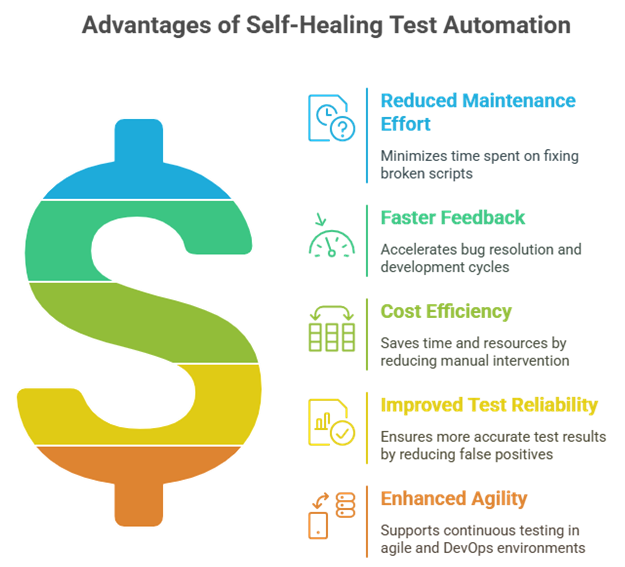
The adoption of self-healing test automation brings numerous advantages to organizations embracing this technology:
Reduced maintenance effort stands out as perhaps the most immediate benefit. QA teams no longer need to spend countless hours fixing broken scripts after every sprint or release. This dramatic reduction in maintenance overhead allows testers to focus on more valuable activities, such as designing new tests, improving coverage, and investigating genuine defects.
Faster feedback represents another crucial advantage. With resilient test scripts that continue running despite application changes, test cycles remain uninterrupted. This accelerates feedback to developers, enabling faster bug resolution and smoother development cycles. In continuous integration/continuous deployment (CI/CD) environments, where rapid feedback is essential, self-healing tests can be the difference between meeting or missing release deadlines.
Cost efficiency naturally follows from these improvements. By minimizing manual intervention and reducing the time spent on script maintenance, organizations save both time and resources. According to industry analyses, maintenance costs for traditional test automation can consume up to 70% of testing resources. Self-healing automation significantly reduces this burden, resulting in substantial cost savings over time.
Improved test reliability is another significant benefit. Self-healing reduces false positives caused by minor UI or structural changes, ensuring more accurate test results. This increased reliability builds greater confidence in the testing process and allows teams to make more informed decisions about software quality.
Enhanced agility completes the picture. In today’s agile and DevOps environments, where speed is critical, self-healing scripts ensure continuous testing aligns seamlessly with rapid deployment cycles. This alignment enables organizations to maintain quality standards while accelerating their pace of innovation.
Implementation Best Practices
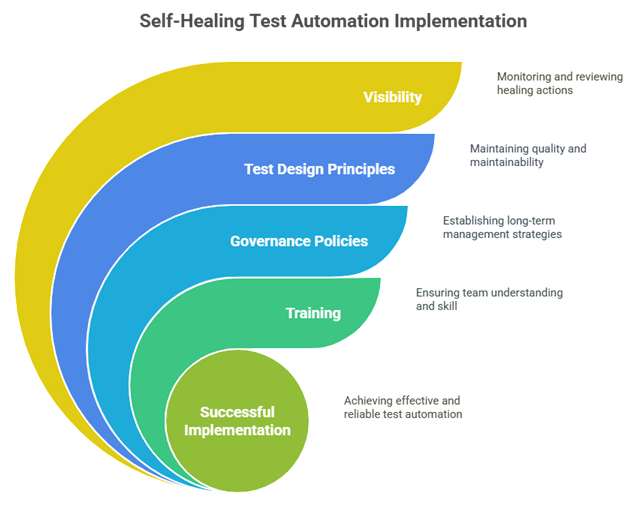
While self-healing test automation offers tremendous benefits, successful implementation requires careful planning and adherence to best practices:
Start small and scale gradually. Begin by implementing self-healing for your most critical and stable test suites before expanding to more complex scenarios. This approach allows your team to gain experience with technology and establish effective workflows.
Maintain visibility into healing actions. Even though tests can self-heal, it’s important to monitor and review the adaptations they make. Regular reviews help ensure that the healing mechanisms are working as expected and provide insights for improving test design.
Combine with good test design principles. Self-healing is not a substitute for well-designed tests. Continue to follow test automation best practices, such as creating modular, maintainable test scripts with clear assertions and proper separation of concerns.
Establish governance policies. Decide how your team will handle self-healing adaptations in the long term. Will you permanently update test scripts based on successful adaptations, or will you treat them as temporary fixes that prompt developer review?
Invest in training. Ensure your QA team understands how self-healing works and how to maximize its benefits. This knowledge enables them to design tests that work effectively with self-healing mechanisms and troubleshoot any issues that arise.
The Future of Self-Healing Test Automation
The evolution of self-healing test automation is just beginning. As AI and machine learning technologies continue to advance, we can expect even more sophisticated healing capabilities that not only adapt to changes but anticipate them before they happen.
Future self-healing systems might analyze code commits and application changes to proactively update test scripts before they even run, eliminating the need for runtime adaptation. They could also provide intelligent suggestions for test coverage based on application usage patterns and risk analysis.
Integration with other emerging testing approaches, such as visual testing and API contract testing, will create comprehensive quality assurance ecosystems that are both powerful and resilient. These integrated systems will further reduce the maintenance burden while expanding test coverage across all aspects of modern applications.
For organizations aiming to stay competitive in today’s digital landscape, adopting self-healing test automation is increasingly becoming a necessity rather than a luxury. Those who embrace this technology now will be well-positioned to deliver higher-quality software at the speed demanded by modern business.
Conclusion
Self-healing test automation represents a paradigm shift in how we approach software quality assurance. By leveraging the power of artificial intelligence and machine learning, this technology addresses one of the most persistent challenges in test automation: maintenance overhead. As applications continue to evolve at an accelerating pace, the ability of tests to adapt automatically to changes becomes not just a convenience but a necessity.
As we look to the future, self-healing test automation will continue to evolve, becoming more intelligent, more proactive, and more integrated with the broader software development lifecycle. For quality assurance professionals, this technology offers an opportunity to shift focus from repetitive maintenance tasks to strategic quality initiatives that drive genuine business value.